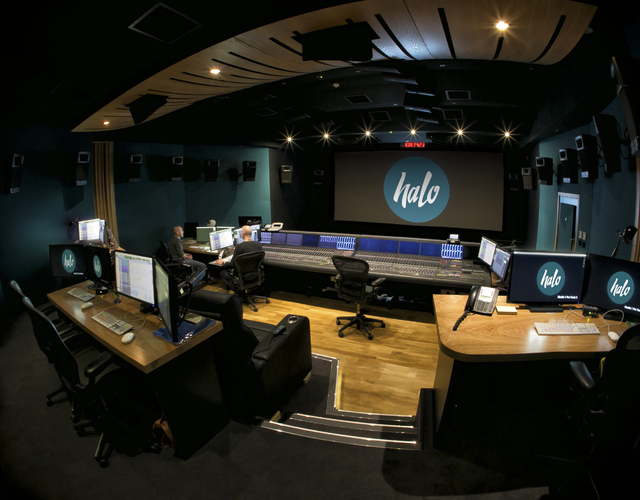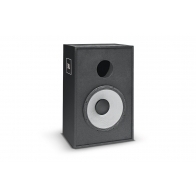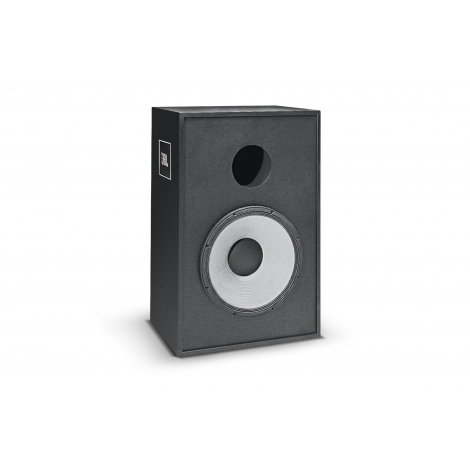Products
Major London TV and feature film post production studio, halo, has carried out a major £300k upgrade of its main Studio 1 film dubbing stage, which it acquired towards end of 2011 after taking on the lease at 25 Noel Street in Soho.
As one of only three cinema-scale audio mix rooms in central London, halo had earmarked this as the first phase in a comprehensive refit of the 10,000sq. ft building, converting the stage into a Dolby Atmos environment, based around 46 JBL loudspeakers. The speakers, along with the Crown DCi-N network amplifiers and BSS Soundweb DSP, were supplied by Sound Technology, who distribute these and other HARMAN brands in the UK and Ireland.
Providing technical support from Sound Technology was Senior Application Engineer, Ben Todd. He explained that with Atmos gaining traction in the industry, halo had felt the time was right to bring their main studio up to a reference spec.
With halo’s Head of Audio Operations Richard Addis, and Lead Mix Technician Johnathan Rush overseeing the implementation, in addition to the new generation technology, a heavy commitment was made at the same time to updating the room aesthetics, in order to provide a level of comfort and quality to match the already very highly regarded room acoustics.
halo, at first, had been reticent to change from their existing trusty bi-amped JBL loudspeakers. “So we persuaded them to have a demo of the tri-amped [JBL] 3732T ScreenArray to ensure that their LCR channels were up to date and worthy of the room,” said Todd. Sound Technology provided demo units of all JBL loudspeakers and Crown DCi-N amplifiers for the purpose, and according to Todd, “the demo convinced their well trained ears that the upgrade was justified.”

The JBL 3732T is designed for use in both studio applications and the best of commercial cinema screens. It uses technology found elsewhere in the JBL range, and so consequently the DNA of these designs is shared with a high percentage of speakers found in mainstream cinemas. Stated Richard Addis. “What it means for engineers is that they can be confident that if a mix sounds right in halo Studio 1, then it should transfer especially well to the real world. There is a lot to be said for having the same speakers as you would expect to find in mainstream multiplexes.”
Dolby advised on the remainder of the system using various JBL 9300 Series Cinema Surrounds and JBL AC18 and AC28 overhead channels, along with JBL 4642A screen subs and 4645C surround subs. Again, these high performance systems can be found at good quality complexes.Crown’s DCi Drivecore Network series amplifiers were selected as the obvious partners. Their high-performance DSP and converters, matched to their low distortion and high damping factor output stages, ensure tight, detailed and articulate reproduction of the mix material. They also feature BLU link, HARMAN’s low latency, high-channel capacity digital audio bus, which allows a high resolution, simple, cost-effective and resilient way to achieve a complete digital signal path when used in conjunction with the BSS BLU-806 DSP processor.
In this application, halo decided on the BSS BLU-806, with its configurable I/O, for a number of reasons, enabling them to switch effortlessly from Atmos configuration to 5.1, 7.1, IMAX or DTS:X. “The BSS Soundweb London platform is a proven product in multi-channel post production, and allows facilities the flexibility to design a control interface and signal path to suit their requirements,” observed Addis. “The BLU-806 also has the high quality audio path and well-respected filters that earned BSS their reputation for sonic excellence.”
The Soundweb device can receive audio via AES and DANTE and route and condition the signal before passing it through to the amps on BLU link. A Focusrite RedNet D64R provides the MADI-DANTE bridge and interfaces between the Dolby RMU and BSS BLU-806. Continued Richard Addis, “Using BLU link distribution to the amps means that significantly less cabling is required since all audio is distributed over a Cat6 ring.”

Of the installation itself, Ben Todd recalls, “Time was very tight, so there was no margin for failure.” The studio was dark for just four weeks during which all the works had to be completed, tested and ready to start.
“We worked together with [technology solutions provider] Jigsaw24 and halo to test the proposed digital infrastructure offsite and ensure that the different parts from all manufacturers worked in conjunction with one another and were set up for optimal reliability.
The redesign of this 105 sq. metre space, including the acoustics and repositioning of seats for editors, directors and clients, was undertaken by Level Acoustic Design.
Summing up, Richard Addis said, “The installation went unusually smoothly, which was a testament to hard work and meticulous planning. It was completed slightly ahead of time, which is almost unheard of.”
Since the upgrade of Studio 1, several major blockbusters have been mixed through the JBL Cinema System, including Ghost Stories, Darkest Hour and Paddington 2. “The feedback from everyone who has mixed here has been overwhelmingly positive,” he concluded.
November 2017
Venue
- halo
- Central London TV and film post-production studio
Project Team
- Supplier: Jigsaw24


















